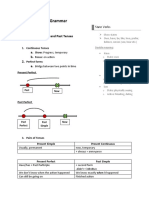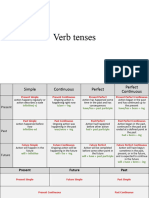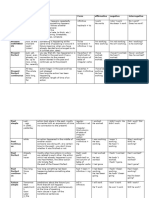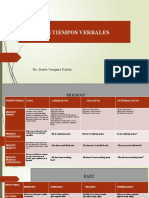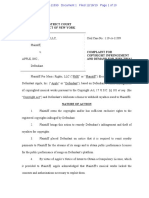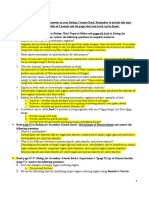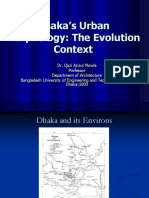0 ratings0% found this document useful (0 votes)
41 viewsWritten Assignment For Reading Comprehension - Type 2: Tenses Identification
Written Assignment For Reading Comprehension - Type 2: Tenses Identification
Uploaded by
Syukron FadillahThe document identifies 11 verb tenses and their uses based on examples from a reading passage. It provides the name of each tense, whether it can be active or passive voice, and 1-2 example sentences from the reading that demonstrate the tense's typical use. The tenses identified are: simple present, present continuous, present perfect, present perfect continuous, simple future, future continuous, future perfect, simple past, past continuous, past perfect, and past perfect continuous.
Copyright:
© All Rights Reserved
Available Formats
Download as DOCX, PDF, TXT or read online from Scribd
Written Assignment For Reading Comprehension - Type 2: Tenses Identification
Written Assignment For Reading Comprehension - Type 2: Tenses Identification
Uploaded by
Syukron Fadillah0 ratings0% found this document useful (0 votes)
41 views3 pagesThe document identifies 11 verb tenses and their uses based on examples from a reading passage. It provides the name of each tense, whether it can be active or passive voice, and 1-2 example sentences from the reading that demonstrate the tense's typical use. The tenses identified are: simple present, present continuous, present perfect, present perfect continuous, simple future, future continuous, future perfect, simple past, past continuous, past perfect, and past perfect continuous.
Original Description:
dfg fg f f f
Original Title
add fkr
Copyright
© © All Rights Reserved
Available Formats
DOCX, PDF, TXT or read online from Scribd
Share this document
Did you find this document useful?
Is this content inappropriate?
The document identifies 11 verb tenses and their uses based on examples from a reading passage. It provides the name of each tense, whether it can be active or passive voice, and 1-2 example sentences from the reading that demonstrate the tense's typical use. The tenses identified are: simple present, present continuous, present perfect, present perfect continuous, simple future, future continuous, future perfect, simple past, past continuous, past perfect, and past perfect continuous.
Copyright:
© All Rights Reserved
Available Formats
Download as DOCX, PDF, TXT or read online from Scribd
Download as docx, pdf, or txt
0 ratings0% found this document useful (0 votes)
41 views3 pagesWritten Assignment For Reading Comprehension - Type 2: Tenses Identification
Written Assignment For Reading Comprehension - Type 2: Tenses Identification
Uploaded by
Syukron FadillahThe document identifies 11 verb tenses and their uses based on examples from a reading passage. It provides the name of each tense, whether it can be active or passive voice, and 1-2 example sentences from the reading that demonstrate the tense's typical use. The tenses identified are: simple present, present continuous, present perfect, present perfect continuous, simple future, future continuous, future perfect, simple past, past continuous, past perfect, and past perfect continuous.
Copyright:
© All Rights Reserved
Available Formats
Download as DOCX, PDF, TXT or read online from Scribd
Download as docx, pdf, or txt
You are on page 1of 3
WRITTEN ASSIGNMENT FOR READING COMPREHENSION_
TYPE 2: TENSEs IDENTIFICATION
Based on the reading, I identify the following tenses on the passage:
NO TYPE VOICE SENTENCES FROM THE READING USES
to talk about a habitual action, used to
talk about general truths, used in
ACTIVE I prefer taller women exclamatory sentences beginning with
Simple Present Tense
1 here and there to express what is
(S+V1)
actually happening in the present.
PASSIVE
NEGATIVE
Present Continuous ACTIVE
2 Tense PASSIVE
(S+ be + V-ing) NEGATIVE
used to describe something that
I have decided to set of round the world in searc of the happened in the past, but the exact time
ACTIVE
Present Perfect Tense perfect man it happened is not important. It has a
3
(have/has + V3) relationship with the present
PASSIVE
NEGATIVE
Present perfect ACTIVE
4 Continuous Tense PASSIVE
(Have/Has + V-ing) NEGATIVE
ACTIVE
Simple Future Tense
5 PASSIVE
(S + will)
NEGATIVE
Simple Future Tense ACTIVE
NO TYPE VOICE SENTENCES FROM THE READING USES
(be + going to) PASSIVE
6
NEGATIVE
Future continuous ACTIVE
7 tense PASSIVE
(will be + V-ing) NEGATIVE
ACTIVE
Future Perfect Tense
8 PASSIVE
(will have + V3)
NEGATIVE
used for both recent and
distant past actions. Remember, it is that
ACTIVE Then I went to Thailand
Simple Past Tense the activity you are talking about has
9
(S+ V2) been completed, and is not still going on.
PASSIVE
NEGATIVE I didn’t stay there very long
describes actions or events in a time
ACTIVE I was just like all the other man before now, which began in the past and
is still going on at the time of speaking
Past Continuous Tense describes actions or events in a time
10
(Was/Were + V-ing) before now, which began in the past and
PASSIVE The women I met were either too thin or too fat
is still going on at the time of speaking
but this is in passive condition
NEGATIVE
used in the part of the sentence that
ACTIVE I had plent of money
explains the condition (the if-clause)
Past Perfect Tense PASSIVE
11
(Had + V3) used in the part of the sentence that
NEGATIVE I had not noticed her before explains the condition (the if-clause) but
this in negative condition
NO TYPE VOICE SENTENCES FROM THE READING USES
Something that started in the past and
Past Perfect ACTIVE I had never been able to find a women continued up to another action or time in
12 Continuous Tense the past.
(had been + V-ing) PASSIVE
NEGATIVE
You might also like
- Typographie - A Manual of DesignDocument275 pagesTypographie - A Manual of Designsuperblana100% (21)
- Frans Mind Map PDFDocument1 pageFrans Mind Map PDFAnastasya Zalsabilla Hermawan100% (1)
- 3.5 Abdominal Trauma: Essentials 1 2 3 4 5 6Document1 page3.5 Abdominal Trauma: Essentials 1 2 3 4 5 6Syukron FadillahNo ratings yet
- Lemon Tree AcordeDocument2 pagesLemon Tree AcordeRodolfo FiorinaNo ratings yet
- Tiempos VerbalesDocument6 pagesTiempos VerbalesMaria Ines RoqueNo ratings yet
- Esquemas Gramática B2 @opomaestra - Enproceso PDFDocument35 pagesEsquemas Gramática B2 @opomaestra - Enproceso PDFLucia Garcia CoyNo ratings yet
- Tenses Chart WorkDocument2 pagesTenses Chart WorkvitaNo ratings yet
- Documento 11Document1 pageDocumento 11Alejandra QuecanoNo ratings yet
- Ingles ChuyyyssaDocument9 pagesIngles ChuyyyssaAna RobledoNo ratings yet
- Present and Past TensesDocument3 pagesPresent and Past TensesAia NikolovaNo ratings yet
- English Assignment 2Document6 pagesEnglish Assignment 2Parvatham GaneshNo ratings yet
- Present Simple Present Continuous Present Perfect: English TensesDocument1 pagePresent Simple Present Continuous Present Perfect: English TensesKhaled AdelNo ratings yet
- Tiempos Verbales Tabla UsosDocument3 pagesTiempos Verbales Tabla Usossilcab67No ratings yet
- TENSEs by SabinaaDocument5 pagesTENSEs by SabinaaSabina AmirNo ratings yet
- Mind MapDocument2 pagesMind MapPadilla Aguillon Miguel angelNo ratings yet
- Verb & Verbal: Pengertian, Rumusdancontohkalimat Past Future Perfect Continuous TenseDocument7 pagesVerb & Verbal: Pengertian, Rumusdancontohkalimat Past Future Perfect Continuous TenseMaulita Miftahul JanahNo ratings yet
- Grammar Tenses OverviewDocument1 pageGrammar Tenses Overview225643No ratings yet
- Verb TensesDocument20 pagesVerb Tensesvpetrovaa23No ratings yet
- Tense Signal Words Use Form Examples: Simple PresentDocument2 pagesTense Signal Words Use Form Examples: Simple Presentmadalin0000No ratings yet
- Revision of TensesDocument5 pagesRevision of Tensessabinameloni88No ratings yet
- Grammar Tenses Table PDFDocument2 pagesGrammar Tenses Table PDFDaniel MiuNo ratings yet
- How Many Tenses Are There in EnglishDocument9 pagesHow Many Tenses Are There in EnglishSusarla SuryaNo ratings yet
- Grammar Rules SummaryDocument3 pagesGrammar Rules Summarymalintha999No ratings yet
- Verbal Times Review: Structures Example When They Are UsedDocument4 pagesVerbal Times Review: Structures Example When They Are UsedDiego GonzalezNo ratings yet
- Ch5tensespdf PDFDocument1 pageCh5tensespdf PDFJesRomeroNo ratings yet
- Usage of Different TensesDocument2 pagesUsage of Different TensesBernadetteLimNo ratings yet
- Tenses ResumenDocument8 pagesTenses ResumenMailen Lo Pilato BloisNo ratings yet
- Verb Forms Guide - A4Document1 pageVerb Forms Guide - A4Juan Miguel Ala TolentinoNo ratings yet
- Chapter IIDocument5 pagesChapter IIIka Nur HaryatiNo ratings yet
- Communicative Function of Verb Tenses - TABLE - 2017-1Document2 pagesCommunicative Function of Verb Tenses - TABLE - 2017-1Jaiber SosaNo ratings yet
- Past Simple & ContinuousDocument7 pagesPast Simple & ContinuoussolodeilseNo ratings yet
- Past Continuous Tense and Simple Past Tense ZadaDocument2 pagesPast Continuous Tense and Simple Past Tense ZadazadafavshaNo ratings yet
- Complete The Chart With The English Tenses: Structure and Use. Add ExamplesDocument5 pagesComplete The Chart With The English Tenses: Structure and Use. Add ExamplesAlondra VázquezNo ratings yet
- English GrammerDocument12 pagesEnglish GrammerSathish KumarNo ratings yet
- Simple Future TenseDocument5 pagesSimple Future TensefinnaradjaponoNo ratings yet
- Present ContinuousDocument1 pagePresent ContinuousIngenieria Ejecuciòn en Prevenciòn de Riegos 2021No ratings yet
- Carrera Lazo Patricio - Portfolio 1Document3 pagesCarrera Lazo Patricio - Portfolio 1Patricio Luis Carrera LazoNo ratings yet
- 02 Summary of Tenses & Aspects of VerbsDocument10 pages02 Summary of Tenses & Aspects of Verbslasnfbf asigfnNo ratings yet
- Perfect Tenses Cheat Sheet: by ViaDocument2 pagesPerfect Tenses Cheat Sheet: by ViaAura SkyNo ratings yet
- TensesDocument3 pagesTensesHihachi SarahNo ratings yet
- Tenses and Aspects of VerbsDocument2 pagesTenses and Aspects of VerbsTrina CanizoNo ratings yet
- Fakta, Kebiasaan, Dan Kejadian Yang Terjadi Pada Saat IniDocument6 pagesFakta, Kebiasaan, Dan Kejadian Yang Terjadi Pada Saat InimofetNo ratings yet
- Az Angol Nyelv Legfontosabb Nyelvtani Elemei: Igeidők És Feltételes MódokDocument4 pagesAz Angol Nyelv Legfontosabb Nyelvtani Elemei: Igeidők És Feltételes MódokKataLhanaVargaNo ratings yet
- 2-bac-grammar-summaryDocument10 pages2-bac-grammar-summaryoximoNo ratings yet
- TENSEs by SabinaDocument3 pagesTENSEs by SabinaSabina AmirNo ratings yet
- 16 TensesDocument4 pages16 Tensessifaalfiana098No ratings yet
- Grammar TableDocument4 pagesGrammar TabletolututorsNo ratings yet
- Grammar Table 16 Escalones LeticiaDocument4 pagesGrammar Table 16 Escalones LeticiatolututorsNo ratings yet
- Aa3 InglesDocument1 pageAa3 InglesMariana ValenteNo ratings yet
- Tenses ResumenDocument6 pagesTenses ResumenMailen Lo Pilato BloisNo ratings yet
- The Following Table Summarizes The 16 Tenses in EnglishDocument9 pagesThe Following Table Summarizes The 16 Tenses in Englishsoto amilkar100% (1)
- Inclusive Grammar Part 2 PDFDocument28 pagesInclusive Grammar Part 2 PDFprobook450_ehsanNo ratings yet
- 20240925 Perfect tensesDocument9 pages20240925 Perfect tensesregistrona310No ratings yet
- Grammar Table 16 Escalones Miguel ÁngelDocument4 pagesGrammar Table 16 Escalones Miguel ÁngeltolututorsNo ratings yet
- Adverbs, Present Perfect, Present Perfect Simple Passive, Present Perfect ContinuousDocument10 pagesAdverbs, Present Perfect, Present Perfect Simple Passive, Present Perfect ContinuouslealtorresalejandroNo ratings yet
- Los Tiempos VerbalesDocument4 pagesLos Tiempos VerbalesNaos SchwaNo ratings yet
- GE 1st MeetingDocument29 pagesGE 1st MeetingintifadhahNo ratings yet
- Verbs & Tenses - Class MaterialDocument7 pagesVerbs & Tenses - Class MaterialJuhika BhattNo ratings yet
- Unit_12_-_The_Passive_1Document20 pagesUnit_12_-_The_Passive_1Bety AnaNo ratings yet
- Hiperglukagon InggrisDocument3 pagesHiperglukagon InggrisSyukron FadillahNo ratings yet
- Defiisi Patofisiologi Subjective +objective Assessment Plan PrognosisDocument2 pagesDefiisi Patofisiologi Subjective +objective Assessment Plan PrognosisSyukron FadillahNo ratings yet
- Medind Nic inDocument8 pagesMedind Nic inSyukron FadillahNo ratings yet
- Carut Marut Pendidikan Dokter Di IndonesiaDocument19 pagesCarut Marut Pendidikan Dokter Di IndonesiaSyukron FadillahNo ratings yet
- BodyDocument2 pagesBodySyukron FadillahNo ratings yet
- 1018.duck Blanket and AppliqueDocument6 pages1018.duck Blanket and AppliqueBenevi deNo ratings yet
- Not Alone by Darren Criss, From The Starkid Musical, A Very Potter MusicalDocument1 pageNot Alone by Darren Criss, From The Starkid Musical, A Very Potter MusicalsomewhereonlyiknowNo ratings yet
- S P A N S T R e S S SDocument12 pagesS P A N S T R e S S SAaron Steven PaduaNo ratings yet
- IndependentDocument20 pagesIndependentindy-bcNo ratings yet
- Int Book 2 Print VersionDocument22 pagesInt Book 2 Print VersionShaneNo ratings yet
- Marc Guitar - More Slow Blues Licks in C7Document3 pagesMarc Guitar - More Slow Blues Licks in C7andreas papandreouNo ratings yet
- 10 Effective StrategiesDocument8 pages10 Effective Strategiesjanezslovenac100% (1)
- Biography of Prominent FilipinoDocument2 pagesBiography of Prominent FilipinoLouenna100% (1)
- Samalkot Lab - (16-17 SSR) (Final)Document161 pagesSamalkot Lab - (16-17 SSR) (Final)Phani PitchikaNo ratings yet
- Como Afinar CBGDocument6 pagesComo Afinar CBGAlcides CursinoNo ratings yet
- Sang Kancil and Sang BuayaDocument2 pagesSang Kancil and Sang BuayaNur Najiah IbrahimNo ratings yet
- Answers English Grammar - Tahap 1Document6 pagesAnswers English Grammar - Tahap 1ismaqhaleefNo ratings yet
- Macbeth Packet 2019Document15 pagesMacbeth Packet 2019Michelle0% (1)
- Marion DonovanDocument5 pagesMarion DonovanlauravilameNo ratings yet
- Play Do Learn STD 1st BookDocument98 pagesPlay Do Learn STD 1st Booknutan zambre50% (2)
- Pro Music Rights Copyright LawsuitDocument10 pagesPro Music Rights Copyright LawsuitMikey CampbellNo ratings yet
- Secondary Schools Book I. Then, Answer The Following Questions in Complete SentencesDocument8 pagesSecondary Schools Book I. Then, Answer The Following Questions in Complete SentencesedwinmasaiNo ratings yet
- Action Sigils Ray SherwinDocument3 pagesAction Sigils Ray Sherwinlucky3331625100% (1)
- 6to Mim Unit 1 2016 BDocument2 pages6to Mim Unit 1 2016 BRita OteroNo ratings yet
- Praise and Worship, Powerpoint of The Following Songs: Our God, Lord, I Know You Love Me, Turn Your Eyes Upon Jesus and The Heart of WorshipDocument37 pagesPraise and Worship, Powerpoint of The Following Songs: Our God, Lord, I Know You Love Me, Turn Your Eyes Upon Jesus and The Heart of WorshipYao Yao MongNo ratings yet
- ME8097 NDT UNIT 1 - Lecture 2Document18 pagesME8097 NDT UNIT 1 - Lecture 2MICHEL RAJNo ratings yet
- Clarion 2002 CatalogDocument56 pagesClarion 2002 CatalogFaye Bandoy Velasquez100% (3)
- Diamond Window Cube (Modular Origami) : Food Living Outside Play Technology WorkshopDocument9 pagesDiamond Window Cube (Modular Origami) : Food Living Outside Play Technology WorkshopZach DohertyNo ratings yet
- SSTV CamDocument2 pagesSSTV CamWeerut SrhidharaNo ratings yet
- NGP Pricebook 2011 Lite KitDocument24 pagesNGP Pricebook 2011 Lite KitSecurity Lock DistributorsNo ratings yet
- Dhaka MorphologyDocument50 pagesDhaka Morphologytanzim ornabNo ratings yet
- Ev 1502er PDFDocument2 pagesEv 1502er PDFMelissaNo ratings yet
- Autocad Basics Tutorial HandoutDocument12 pagesAutocad Basics Tutorial HandoutKenshin UzumakiNo ratings yet









